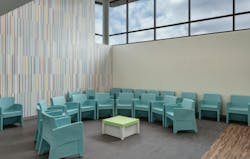Designing behavioral health facilities [AIA course]
Behavioral health facility construction is experiencing a spike in the U.S., due in part to enhanced benefit provisions in the Affordable Care Act that have widened access to mental health treatment. Recent gun violence, mass shootings, the opioid epidemic—these and other social issues with significant behavioral health implications have underscored the need for continued availability of mental health services and well-designed facilities in which to conduct them.
The 2017 Hospital Construction Survey, released jointly by Health Facilities Management and the American Society for Healthcare Engineering of the American Hospital Association, reported that half of the specialty hospitals planned for the next three years are behavioral health centers or psychiatric hospitals.
Yet even as the demand for new and retrofitted space is growing, the supply of behavioral health engineering and design experts is not keeping pace. The sector is also experiencing a decline of knowledge of leading practices in space design and technology integration.
This scenario—growing demand for behavioral health facility beds, accompanied by declining capacity of how to design them properly—is of particular concern when it comes to minimizing inpatient suicide in mental health settings.
After reading this article, you should be able to:
+ Describe the chief differences between designing for behavioral health and designing for general health.
+ Understand ligature risk and why gravity is irrelevant when identifying a ligature risk.
+ List the ways that improper interior design can negatively impact behavioral health patients.
+ Discuss how technology can assist behavioral health facilities to achieve greater patient safety.
